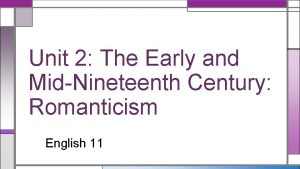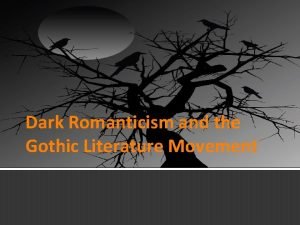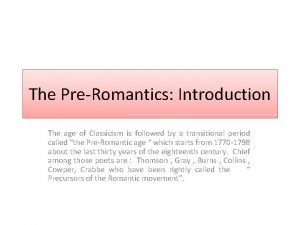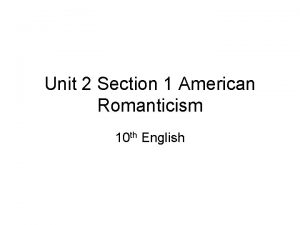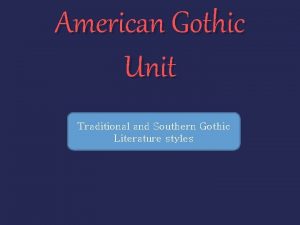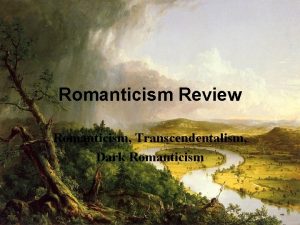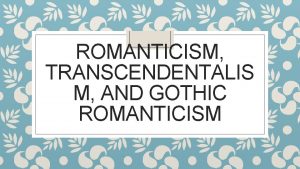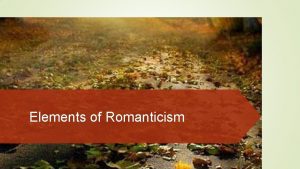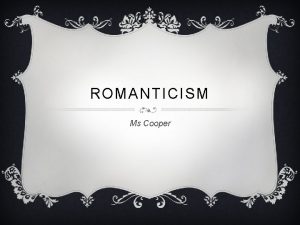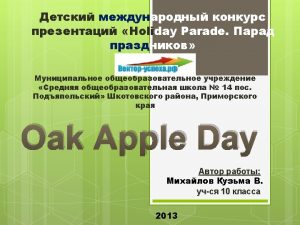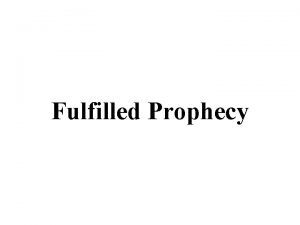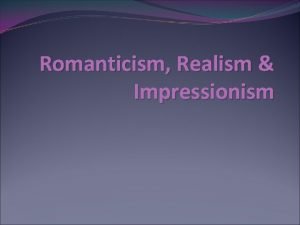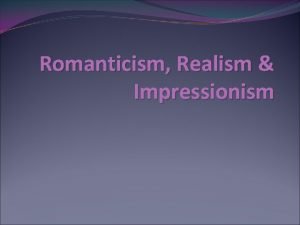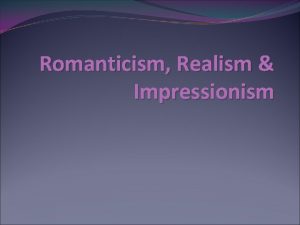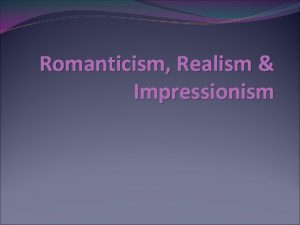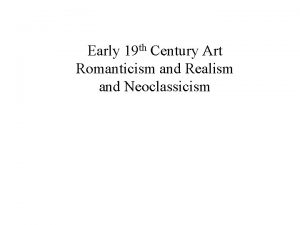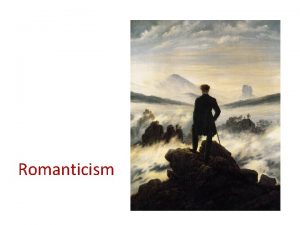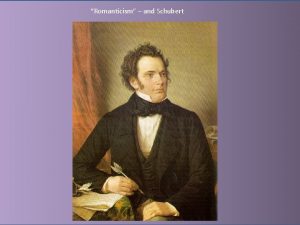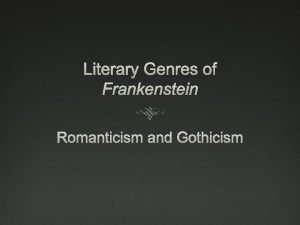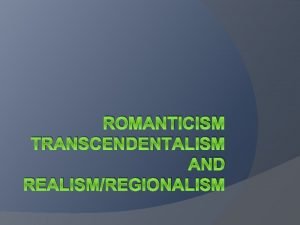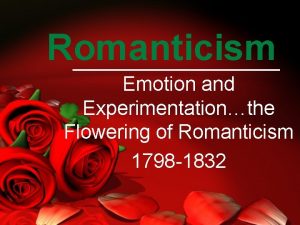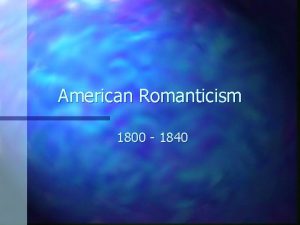Unit 2 The Early and MidNineteenth Century Romanticism

























- Slides: 25

Unit 2: The Early and Mid-Nineteenth Century: Romanticism English 11

The Beginnings of Romanticism Objective In this lesson, you will evaluate the emergence of the romantic period and its literature.

The Beginnings of Romanticism American Romanticism With its emphasis on nature and the individual, romanticism was a reaction to the strict rationalism of the age of reason. The romantics rebelled against what they saw as constrained thinking. They celebrated emotion, creativity, and the mystery and grandeur of nature. Many romantic writers also explored new forms of writing. They often wrote about nature and the everyday experiences of individual men and women.

The Beginnings of Romanticism Characteristics of Romanticism Importance of the individual over (or against) society Exploring the imagination and emotions of the individual An appreciation and respect for nature Nature as a tool for introspection and comfort for humans This focus on the individual exemplifies the idea among romantics that a person derives significant meaning from the individual, rather than society.

The Beginnings of Romanticism The Omniscient Narrator In the romantic era, some authors employed the third-person omniscient narrator to relate a story. omniscient narration - narration in which the narrator has full knowledge of the story's events, as well as the motives and unspoken thoughts of all the characters and past and future events

The Beginnings of Romanticism Reading Selection - "The Devil and Tom Walker“ Washington Irving : "Rip Van Winkle" "The Legend of Sleepy Hollow" He contributed to the romantic era by depicting the darker side of American history, as is demonstrated in his short story "The Devil and Tom Walker. "

The Beginnings of Romanticism Washington Irving's short story "The Devil and Tom Walker" uses third-person omniscient narration. The narrator knows about the events of the story but is removed from the action. This story is an example of how romantics explored the value of the individual.

The Beginnings of Romanticism Archetype - a recurring pattern of characteristics or events on which literary elements such as characters, plots, and themes are based The devil is an archetype in American Romantic literature. The devil symbolizes greed, cruelty, and dishonesty in society. The only character whose thoughts are not revealed to the reader is the devil, referred to in the story as the "Wild Huntsman, " the "Black Miner" and "Old Scratch" (all names for the devil). Even with an omniscient narrator, the story does not present the devil’s thoughts. This idea is consistent with the time period's religious beliefs regarding the devil as an ever-present, mysterious spirit.

The Beginnings of Romanticism Direct characterization - the method of character development in which the author directly tells the reader what a character is like Indirect characterization - when an author uses dialogue, action, and the reaction of other characters to provide insight into a character's personality

The Beginnings of Romanticism Read the excerpt from “The Devil and Tom Walker. ” In a word, Tom's zeal became as notorious as his riches. Still, in spite of all this strenuous attention to forms, Tom had a lurking dread that the Devil, after all, would have his due. That he might not be taken unawares, therefore, it is said he always carried a small Bible in his coat pocket. This information serves as indirect characterization, telling the reader that Tom has not repented from his malevolent ways—his newfound piousness actually is just another form of his greed. Tom uses religion merely to protect himself from the devil.

The Beginnings of Romanticism Satire - a humorous piece of writing that mocks a flawed person or aspect of society with the intention of changing the subject it mocks Look for the satirical element as you read the excerpt from “The Devil and Tom Walker. ” He insisted that the money found through his means should be employed in his service. He proposed, therefore, that Tom should employ it in the black traffic; that is to say, that he should fit out a slave ship. This, however, Tom resolutely refused: he was bad enough in all conscience, but the Devil himself could not tempt him to turn slave-trader.

The Beginnings of Romanticism Washington Irving uses Satire – Although Tom shuns slavery, he still oppresses people by extorting money from them.

Focus on Language Relative Clauses • Relative clauses are dependent clauses that modify a noun or noun phrase. They are introduced by a noun, pronoun, or adjective that can be—but does not need to be—written explicitly. • There are two types of relative clauses: restrictive and nonrestrictive.

Focus on Language The purpose of a restrictive clause, or essential clause, is to further define something in a sentence. If a restrictive relative clause is removed, it changes the core meaning of the sentence, as in this excerpt from Nathaniel Hawthorne's "The Birthmark": – It needed but a glance with the peculiar expression that his face often wore to change the roses of her cheek into a deathlike paleness. . . • The relative pronoun that makes this clause a relative clause which modifies the noun, expression. This relative clause is restrictive because the clause is essential to understanding the meaning of the sentence.

Focus on Language Which sentences contain a restrictive clause? 1. We fed the kittens that we found in the shed. 2. My grandmother, who was growing crankier by the day, scolded him harshly. 3. This is the house that I grew up in. 4. Our teacher, who was always ready to share in a good joke, laughed with us.

Focus on Language Which sentences contain a restrictive clause? 1. We fed the kittens that we found in the shed. 2. My grandmother, who was growing crankier by the day, scolded him harshly. 3. This is the house that I grew up in. 4. Our teacher, who was always ready to share in a good joke, laughed with us.

Reading Practice Read the following sentences. Using context clues, identify which word in the list has a similar meaning to the underlined word in the sentence. bleak favorable dangerous conciliatory At this propitious time of public distress did Tom Walker set up as a usurer in Boston. He was sulky, however, and would not come to terms: she was to go again with a propitiatory offering, but what it was she forbore to say. Tom had long been picking his way cautiously through this treacherous forest; stepping from tuft to tuft of rushes and roots, which afforded precarious footholds among deep sloughs. It was a dreary memento of the fierce struggle that had taken place in this last foothold of the Indian warriors.

Reading Practice favorable propitious conciliatory propitiatory dangerous precarious bleak dreary

Elements of Romantic Literature Objective In this lesson, you will identify and examine literary techniques used in romantic literature.

Elements of Romantic Literature Allusions and Irony in Romantic Literature An allusion is an indirect or passing reference to a historical person or event, literary work, character, or passage. Allusions are powerful literary tools because they add depth and layers of meaning by associating a specific idea, character, or event that exists outside the text with a specific reference within the text

Elements of Romantic Literature Allusions and Irony in Romantic Literature A famous example is "Call me Ishmael, " the opening line of Herman Melville's whaling adventure Moby-Dick, which introduces the novel's narrator and is an allusion to the biblical figure of Ishmael. The biblical Ishmael's father casts him out to wander in the wilderness, but God protects Ishmael and he survives to become an important patriarch of the Arab peoples, the creator of a new nation. In Moby-Dick, Ishmael is the only survivor of a whaling crew's struggle against a great white whale. He alone lives to tell the epic tale.

Elements of Romantic Literature Irony - a literary device used to show the discrepancies between expected outcomes and the realities of life; words used to convey a meaning that is opposite of the literal meaning Irony plays an important role in developing the narration and tone of a story.

Elements of Romantic Literature • Read this sentence from “Bartleby, the Scrivener. ” What is the verbal irony in this excerpt? What does the use of irony tell the reader? • In that direction, my windows commanded an unobstructed view of a lofty brick wall, black by age and everlasting shade; which wall required no spy-glass to bring out its lurking beauties, but, for the benefit of all near-sighted spectators, was pushed up to within ten feet of my window panes.

Elements of Romantic Literature • The sentence is filled with verbal irony. If taken literally, the reader would think that the narrator enjoys the beauty of old, blackened brick walls, and is pleased that his window is so close to one as to afford him a good view. Identifying the use of verbal irony in this sentence allows the reader to understand that the narrator is actually disgruntled with the scene his window presents.

Elements of Romantic Literature •
 Pretest the early and mid-nineteenth century romanticism
Pretest the early and mid-nineteenth century romanticism Unit 6 early 20th century ga
Unit 6 early 20th century ga Dark romanticism vs gothic
Dark romanticism vs gothic Pre romantic period
Pre romantic period The romanticism (1795 — 1835) what is romanticism
The romanticism (1795 — 1835) what is romanticism Early cpr and early defibrillation can: *
Early cpr and early defibrillation can: * Unit 2 lesson 10 american romanticism test
Unit 2 lesson 10 american romanticism test American gothic examples
American gothic examples Unit 6 review questions
Unit 6 review questions Hình ảnh bộ gõ cơ thể búng tay
Hình ảnh bộ gõ cơ thể búng tay Ng-html
Ng-html Bổ thể
Bổ thể Tỉ lệ cơ thể trẻ em
Tỉ lệ cơ thể trẻ em Voi kéo gỗ như thế nào
Voi kéo gỗ như thế nào Thang điểm glasgow
Thang điểm glasgow Chúa yêu trần thế alleluia
Chúa yêu trần thế alleluia Môn thể thao bắt đầu bằng chữ f
Môn thể thao bắt đầu bằng chữ f Thế nào là hệ số cao nhất
Thế nào là hệ số cao nhất Các châu lục và đại dương trên thế giới
Các châu lục và đại dương trên thế giới Công thức tính thế năng
Công thức tính thế năng Trời xanh đây là của chúng ta thể thơ
Trời xanh đây là của chúng ta thể thơ Cách giải mật thư tọa độ
Cách giải mật thư tọa độ Làm thế nào để 102-1=99
Làm thế nào để 102-1=99 Phản ứng thế ankan
Phản ứng thế ankan Các châu lục và đại dương trên thế giới
Các châu lục và đại dương trên thế giới Thơ thất ngôn tứ tuyệt đường luật
Thơ thất ngôn tứ tuyệt đường luật
